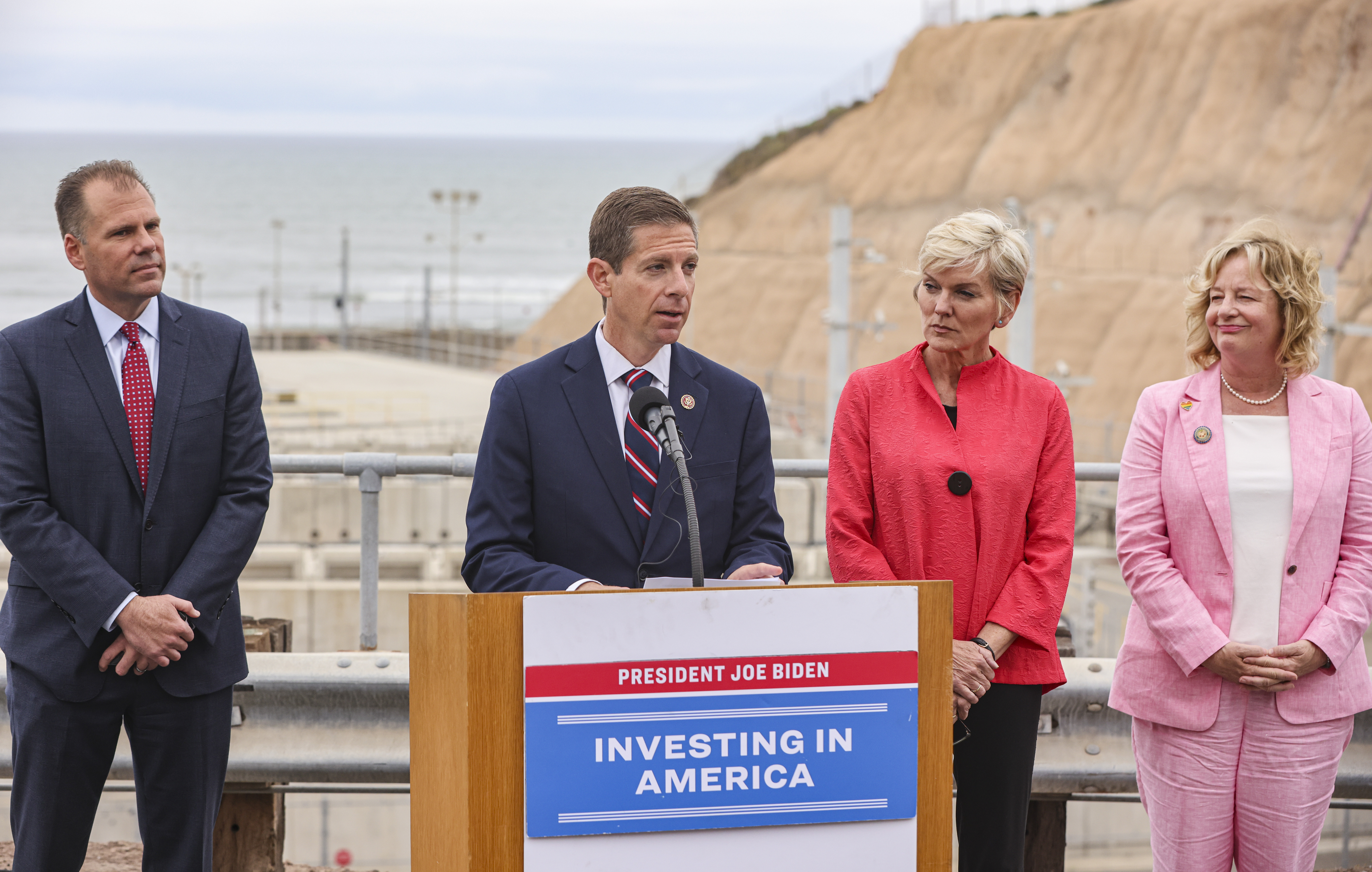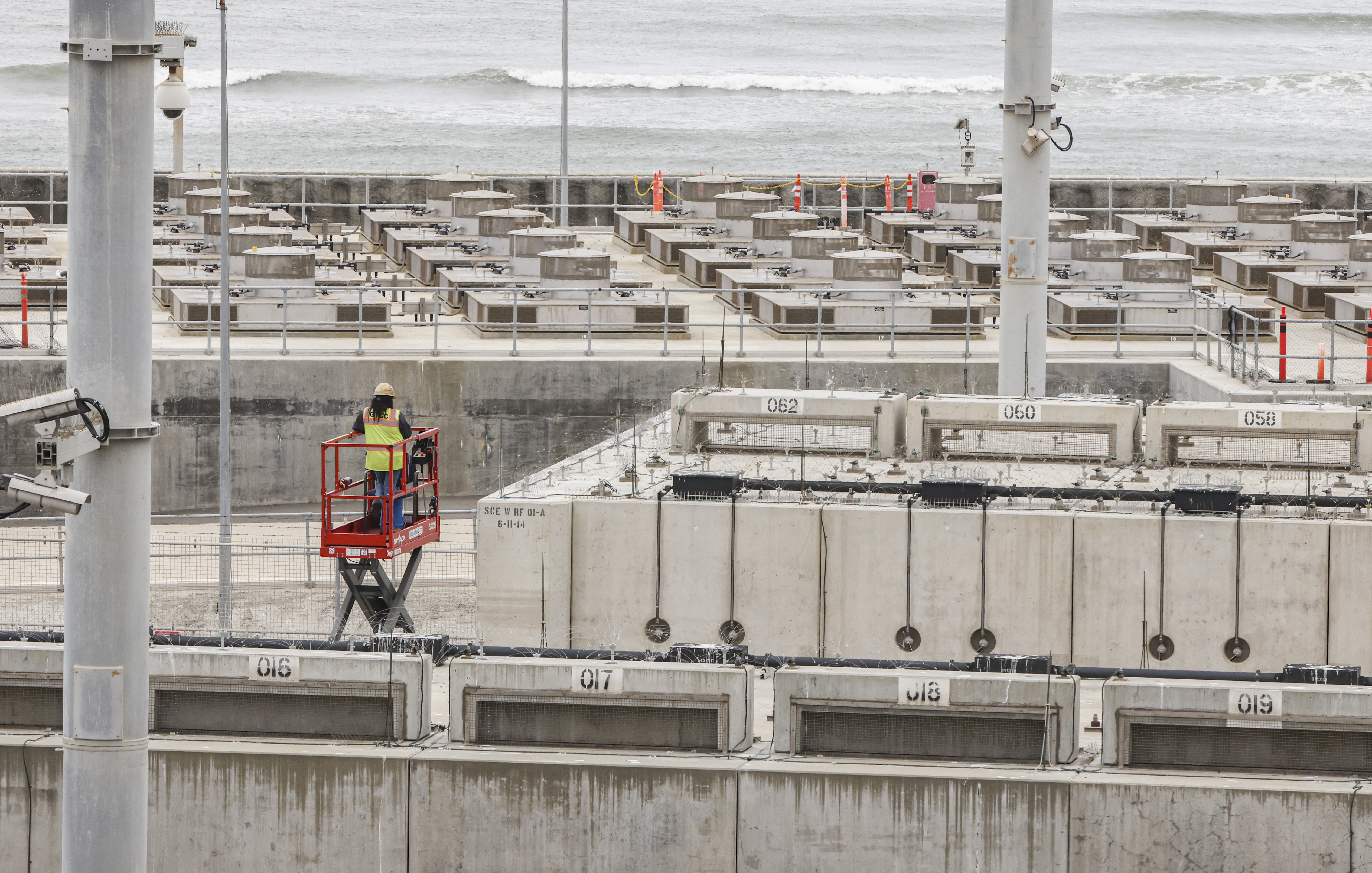The FBI launches a search for communities willing to take nuclear waste from San Onofre and other plants
Rob NikolevskiJune 9, 2023
With the San Onofre nuclear power plant in the background, US Secretary of Energy Jennifer Granholm announced Friday that the Biden administration will spend $26 million on what will be one of many steps to solve a decades-long problem: where should the nuclear waste be stored? which has been accumulating at commercial power plants across the country.
Granholm said “we all need to find the solution” to the waste problem and said a national search will be launched to find communities willing to take spent fuel rods from sites like San Onofre on a temporary basis until the federal government makes a permanent repository.
The 3.55 million pounds of spent radioactive fuel stored at the closed-down San Onofre Nuclear Power Plant has long been a source of fear for some Southern Californians, who pass the iconic twin domes as they drive down Interstate 5. More than 9 million people live within 50 miles of the plant.
About 73 jerrycans loaded with spent fuel assemblies have been lowered into vertical cavities at a storage site on the north side of the plant, behind a seawall just over 100 feet from the Pacific Ocean. Nearby, another 50 dumpsters are lined up horizontally.
To identify potential sites, the Energy Department will fund 13 groups from different parts of the country to participate, set up workshops and get feedback from communities that may be interested in building temporary facilities. The 13 group partnerships with universities, industry and non-profit organizations will receive approximately $2 million each.
The blistering heat in California led to power shortages last summer. Here’s the forecast for this year
“Some communities don’t know what it means,” Granholm said. “They may be in, they may be out, but the bottom line is we need to form trust and be able to educate them and work with them on what their concerns are.”
Ultimately, the Energy Department and the Biden administration want to find one to three communities for what the nuclear industry calls “consolidated temporary storage” facilities.
According to a report released in April, the Energy Department estimates that the entire process of identifying, screening, selecting and then building a temporary storage site will take 10 to 15 years.
“At this stage, we’re starting the conversation,” said Kathryn Huff, deputy secretary of the Office of Nuclear Energy in the Energy Department.

Rep. Mike Levin (D-San Juan Capistrano) joined Granholm on a tour of the San Onofre Nuclear Generating Station, known as SONGS
in brief
.
“We finally have a plan when it comes to spent fuel in the United States,” Levin said. “Now we have to execute that plan.”
Under the Nuclear Waste Policy Act of 1982, the federal government has a legal responsibility to dispose of the approximately 89,000 tons of waste that has accumulated at nuclear power plants in 35 states.
A giant underground permanent repository was nearing completion on Yucca Mountain in southern Nevada, but in 2010 the Obama administration halted the project, after years of opposition from Silver State lawmakers, including former Senate Majority Leader Harry Reid.
With Yucca off the table, the focus has shifted to finding temporary facilities.
The revolving door at utilities? It’s alive and kicking
To avoid a repeat of Yucca, the Energy Department is now taking a consent-based approach to find communities that might be open to building a storage facility because of the prospect of more local jobs and economic growth.
“Anything that doesn’t include permission can easily be delayed or shut down completely,” Huff said. “And we really intend to get to a robust and lasting solution here, something that will outlast this administration and make a longer-term commitment.”
But finding those communities can be difficult.
A proposed temporary facility in southeastern New Mexico has been opposed by Gov. Michelle Lujan Grisham and the New Mexico Legislature passed a bill earlier this year that would prohibit the storage and disposal of radioactive waste without state consent. The matter may end up in court.
A similar story plays out in Texas. A potential storage project in the town of Andrews
touts it can be touted as capable
holding as much as 40,000 tons of spent nuclear fuel for up to 40 years, but Gov. Greg Abbott tweeted, Texas will not become America’s nuclear dump. (For perspective, San Onofre stores about 1,610 tons of spent fuel on its property.)
PG&E can continue to operate Diablo Canyon at least for now, the FBI says
One of the concerns for communities considering building a temporary storage facility: Will they be stuck with the waste for decades, if the federal government doesn’t find a permanent location?
“That’s why we want to have a discussion,” Granholm said, “to let [the communities] know what the law says, what the specifics are, make them feel comfortable. If they don’t want it, we don’t want to force it on anyone. We’re confident from the discussions we’ve had right now that there are communities that are willing to take those discussions to have a temporary site.”
There are signs of progress in other countries.
Finland, for example, is nearing completion of its spent fuel storage facility at Onkalo, which will permanently hold 6,500 tons of waste produced over the lifetime of the country’s five nuclear reactors. Canada is expected to announce a location for a national repository in fall 2024.
“We haven’t done this well in the United States in the past,” Granholm said. “We said, ‘Okay, Yucca Mountain, it’s you,’ without getting the consent of the most affected community. Here’s what we learned from Finland and Canada. They had a process that was very respectful of communities.. . and that’s what we’re going to do.”
As for the search for a permanent site to replace Yucca Mountain, Granholm said it will begin once permission is approved. “The first step is [interim facilities] and we’ll get into that later.”

On Capitol Hill, Levin has helped secure $93 million in funding over the past three fiscal years to move permission-based establishments.
Levin and Rep. Darrell Issa (R-Bonsall) this week reintroduced legislation that would prioritize the removal of spent fuel from decommissioned plants such as SONGS located in areas of high population and seismic hazards.
“We know it can be done,” Levin said. “We can do it here and it will work here. It won’t happen overnight, but we finally have the momentum that we’ve been missing for the last 10 or 15 years.”
San Onofre has not produced electricity since 2012 after a leak in a steam generator tube led to its shutdown. The plant is now being decommissioned and is in its fourth year of a $4.5 billion decommissioning project that will take about eight years to complete and remove about 1.1 billion pounds of material from the site.
The factory’s two distinctive domes, each 60 meters high, are expected to be phased out from late 2026 or early 2027.
Representatives for Southern California Edison, which operates San Onofre, said Friday that more than 80% of buses could now be removed from the site if a storage facility were in place and that 100% of buses will be ready to go by 2030. are sent.
Nikolewski writes for the San Diego Union-Tribune.
Fernando Dowling is an author and political journalist who writes for 24 News Globe. He has a deep understanding of the political landscape and a passion for analyzing the latest political trends and news.



